Banana and plantain (Musa sp.) are widely grown in India with great socio- economic significance, interwoven in the cultural heritage of the country. It is fourth important food crop in terms of gross value exceeded only by paddy, wheat and milk products. It is also a dessert fruit for millions apart from a staple food owing to its rich and easily digestible carbohydrates with a calorific value of 67-137 /100g fruit. India is the largest producer of banana in the world. In India, banana contributes to 37.30 % of the total fruit production. Tripura is a small grower of banana in the north-eastern region.
Banana in Tripura:
|
Area |
7,486 HA |
|
Production |
1, 05,615 MT |
|
Productivity |
14.11 MT / HA |
Various cultivars of banana are grown in Tripura e.g. Sabri, Champa, Dwarf Cavendish, Tissue Culture of Grand Naine, etc. Among the various varieties; Sabri (AAB) is considered the strength of Tripura because it fetches high price round the year on an average ` 6-7 per finger. Banana plantations suffer from many serious diseases such as Fusarium wilt or panama disease, Cercospora leaf spot or Sigatoka, bacterial wilt or Moko disease, burrowing nematode infestation, Bunchy top (a nanavirus), anthracnose and various other post- harvest fruit rots. It is reported that Sabri is highly susceptible of Fusarium wilt or Panama disease. Panama disease and vascular wilt, also known as Fusarium wilt of banana (Musa spp.), is one of the most notorious of all plant diseases. Although the pathogen probably originated in Southeast Asia, the disease was first reported in Australia in 1876. Few banana-producing regions remained free of the disease. Panama disease is now found in all banana-producing regions of India, especially in north eastern region. The disease is a major problem in Tripura state on banana cultivation.
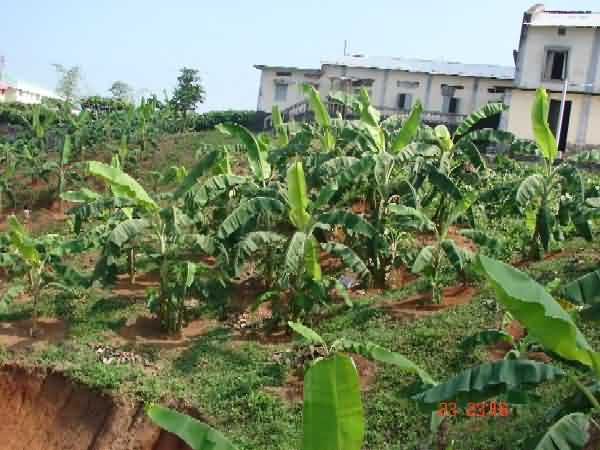
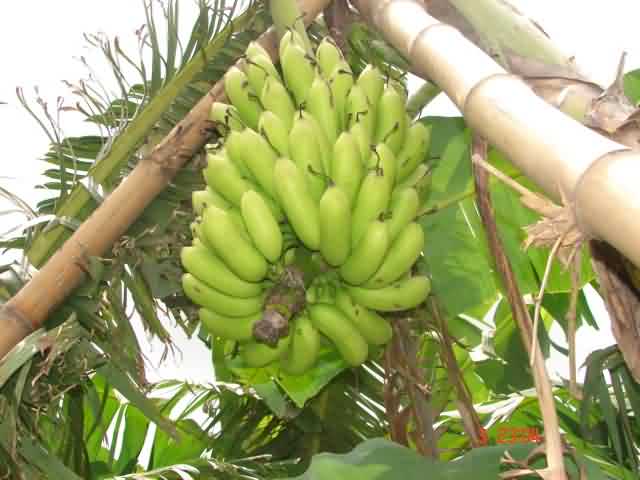
Symptoms
The conspicuous symptoms of Fusarium wilt appear on at least 5 months old banana plants although 2-3 months old plants are also killed under highly favorable conditions for disease development.
(a) Internal symptoms
- The first internal symptoms develop in feeder roots, the initial sites of infection.
- They progress to the rhizome and are most prominent where the stele joins the cortex.
- The pseudo stem is colonized, faint brown streaks or flecks become evident on and within older leaf sheaths.
- Eventually, large portions of the xylem turn a brick red to brown color.
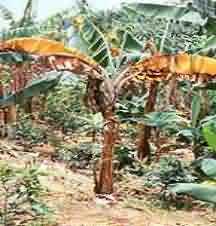 External Symptoms of panama wilt in Banana plant
External Symptoms of panama wilt in Banana plant
(b) External symptoms
- The first external symptoms of Panama disease are a yellowing of the oldest leaves or a longitudinal splitting of the lower portion of the outer leaf sheaths on the pseudostem.
- This is followed by a wilt and buckling of leaves at the petiole base.
- In some cases, these leaves remain green. As the disease progresses, younger and younger leaves collapse until the entire canopy consists of dead or dying leaves.
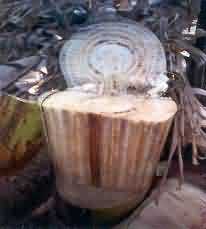 Internal Symptoms of panama wilt in Banana plant
Internal Symptoms of panama wilt in Banana plant
Causal agent
Panama disease is caused by the soil borne fungus Fusarium oxysporum f. sp. cubense. It is one of more than 100 formae speciales (special forms) of F. oxysporum that cause vascular wilts of flowering plants.
Disease Cycle and Epidemiology
- Fusarium oxysporum f. sp. cubense is soil-borne through its thick-walled chlamydospores.
- These spores can remain dormant for several years after the host dies.
- The infection always occurs through injured lateral roots.
- After entry the lateral roots the fungus proceeds to rhizomes where it develops extensively in the vascular tissue before passing up the vascular system into the pseudo stem and other older leaf petioles.
- The disease spreads mainly by contact of the root system of adjacent healthy plants with spores released by the diseased plants.
- The use of infected planting stock is another source of fresh introduction and spread.
Management:
- Sanitation by immediate removal of diseased plants with surrounding soil from the field.
- Use of healthy rhizomes for planting.
- During cultivation avoid root injury.
- Use crop rotation with rice (cereal crops).
- Heat treatment of soil was used recently to manage spread of the pathogen in different parts of India.
- Arbuscular mycorrhizal fungi have been shown to reduce disease severity in short-term green house.
- Tissue-cultured plantlets are free of bacterial, fungal and nematode pathogens and should be used to establish new plantings whenever possible.
- Use of plant injection @ 2 per cent Carbendazim plus Agallol or Aretan soil drench is claimed as an effective method of freeing the planting stock of the pathogen and protection of new plants.
- The additions of highly antagonistic organisms to soil around banana roots give protection to plants against wilt.
- Inoculation with a strain of Pseudomonas fluorescens also provides biological control.
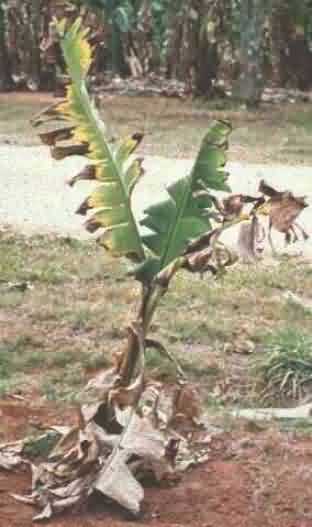
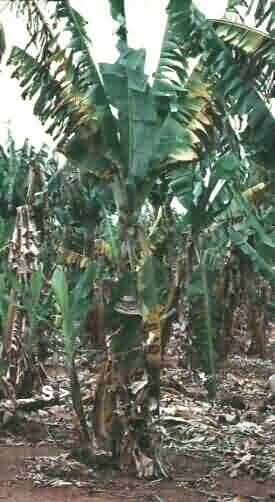
6 Months’ old affected plant 2-3 year old affected Plant
Authors:R.C. Shakywar, Krishna S. Tomar and M. PathakCollege of Horticulture and Forestry,CAU, Pasighat, Arunachal Pradesh
